|
|
|
Sort Order |
|
|
|
Items / Page
|
|
|
|
|
|
|
| Srl | Item |
| 1 |
ID:
105132


|
|
|
|
|
| Publication |
2011.
|
| Summary/Abstract |
Agricultural machinery involves use of equipment and machines that are required to perform various crop production activities. The use of agricultural machinery leads to better utilization of inputs and improvement in agricultural operations, particularly in large scale crop production. Most of the earlier innovations in India in this sector were on tractors and drillers. There has been an increase in the innovations in machinery in the pre-harvest as well as post-harvest operations. The present study attempts to analyse patenting activity to identify current innovations on agricultural machinery in India. Analysis of published applications revealed that the area of irrigation and post-harvest processing had the maximum filing. In the case of granted patents, majority of the patents belong to the area of plant growth and post-harvest operations. The analysis reveals the specific patent portfolios and the scope of future innovations in the agriculture engineering sector.
|
|
|
|
|
|
|
|
|
|
|
|
|
|
|
|
| 2 |
ID:
090973
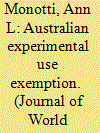

|
|
|
|
|
| Publication |
2009.
|
| Summary/Abstract |
Australian patent law contains no express exemption from infringement for any experimental use of patented inventions. A variety of international and local events became catalysts for two extensive reviews in Australia of the existence of and need for some form of exemption from infringement for experimental and research use of patented inventions. One was conducted as part of a larger investigation by the Australian Law Reform Commission (ALRC): Genes and Ingenuity: Gene Patenting and Human Health. The second was a specific investigation into patents and experimental use by the Advisory Council on Intellectual Property (ACIP). Its final report Patents and Experimental Use was published in 2005. Both reports recommended that the Commonwealth government should amend the Patents Act 1990 to establish an exemption (ALRC) or exception (ACIP) from patent infringement for certain acts involving experimental use of patents. However, while the former Howard liberal government chose to accept the ACIP recommendation in 2007, the new Rudd labour government has not introduced any amendment to date. This article provides a brief overview of the recommendations of those reviews and evaluates the current position in Australia in both the light of the reviews and of subsequent international developments
|
|
|
|
|
|
|
|
|
|
|
|
|
|
|
|
| 3 |
ID:
023482


|
|
|
|
|
| Publication |
Jan 2003.
|
| Description |
5-31
|
|
|
|
|
|
|
|
|
|
|
|
|
|
|
|
| 4 |
ID:
089872


|
|
|
| 5 |
ID:
090967
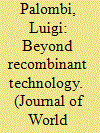

|
|
|
|
|
| Publication |
2009.
|
| Summary/Abstract |
Even though it is not yet clear as a matter of law that isolated biological materials are indeed patentable subject matter, patents over such materials continue to be granted throughout the world. Recently, Craig Venter, the man who wanted to patent the human genome, made history again. This time he has built a synthetic bacterium from the ground up-in a laboratory. The bacterium, Mycoplasma genitalium, is a naturally occurring thing. It is the smallest known bacterium consisting of 582,970 nucleotides. Venter's version of this bacterium is identical, except that he made it. Does this make it an invention? Indeed, Venter has in mind to use this synthetic bacterium, and other synthetic biological materials, as plasmids within which to insert genetic material that is foreign to that organism. The idea is to use these plasmids to manufacture other biological materials. It is a repeat of Cohen and Boyer's idea, which they also patented, but this time the plasmid itself will be a human construct. Is the patent system ready for Venter and his "invention"?
|
|
|
|
|
|
|
|
|
|
|
|
|
|
|
|
| 6 |
ID:
089877
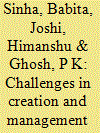

|
|
|
| 7 |
ID:
089878


|
|
|
| 8 |
ID:
124728
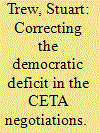

|
|
|
|
|
| Publication |
2013.
|
| Summary/Abstract |
The federal government claims that the Canada-EU Comprehensive Economic and Trade Agreement (CETA) negotiations have been the most transparent and participatory in Canadian history. Labour, environmental, social justice, and other civil society groups that are critical of the proposed agreement for various reasons would argue that their perspectives have been excluded from the official federal dialogue. This article looks at some of the efforts of non-governmental (civil society) actors, and in particular the Trade Justice Network and its member organizations, to affect the CETA negotiations in other ways, with an emphasis on contact with provincial governments, municipalities, European decision makers, and other non-governmental groups in Canada and Europe. It is argued that the exclusion of critical views shows an inherent democratic deficit in the CETA negotiations that privileges corporate insiders at the expense of civil society, the public, and even elected officials. Notwithstanding this deficit, the success of the civil society campaigns can be seen in the problem areas delaying a successful conclusion of negotiations, including new public procurement restrictions for Canadian municipalities and pharmaceutical patent term extensions. For the Trade Justice Network, these areas also help explain how the agreement narrows the fields of economic, environmental, and social governance in Canada.
|
|
|
|
|
|
|
|
|
|
|
|
|
|
|
|
| 9 |
ID:
162242


|
|
|
|
|
| Summary/Abstract |
The impact of national defense research and development spending on overall innovation depends on the extent to which the knowledge and technologies generated by defense funding diffuse. This article uses an original data-set of patents assigned to defense-servicing organizations to investigate the diffusion of military technologies. Contrary to the predictions of the prevailing scholarship, I find no difference in the rate of diffusion between civilian and military technologies. Neither do military technologies assigned to government agencies diffuse at different rates than those assigned to firms. The overall technological experience of the patent assignee is found to be a positive predictor of the diffusion of military technologies. The effect of the prevailing intellectual property rights regime is ambivalent: when US patents are included in the sample, the effect of patent protection is positive, when the US is excluded, the effect is either non-significant or negative depending on the model specification that is utilized.
|
|
|
|
|
|
|
|
|
|
|
|
|
|
|
|
| 10 |
ID:
183860


|
|
|
|
|
| Summary/Abstract |
India and South Africa approached the World Trade Organisation to negotiate the temporary waiver of Intellectual Property (IP) rights on Covid-19 vaccines to remove the artificial barrier of patents and boost vaccine production. This commentary advocates for the waiver of IP rights on Covid-19 vaccines. First, the article makes a case for the debate on the validity of the Covid-19 vaccine to qualify for a patent. Market failure and underinvestment in research and development arguments do not hold for granting a patent to Covid vaccines. Next, the article briefly reviews the evidence on the association between vaccination and virus mutations. Evidence suggests that waiving patents is vital to increase vaccination worldwide and curb mutation and reduce the risk of more infectious new variants. Finally, the article argues that the rationale for a patent is economical, based on incentivising innovation and therefore, the losses suffered by various sectors of the economy due to new variant induced fatalities and lockdowns need to be considered for a case for its waiver.
|
|
|
|
|
|
|
|
|
|
|
|
|
|
|
|
| 11 |
ID:
085863


|
|
|
|
|
| Publication |
2008.
|
| Summary/Abstract |
The Agreement on Trade-Related Aspects of Intellectual Property Rights is the most important as well as the most controversial instrument to date concerning intellectual property protection. What is not clear is the impact it will have on developing countries and whether it will actually meet its objective in the "… promotion of technological innovation and to the transfer and dissemination of technology …". The proponents of a strong patent regime vehemently argue that strengthening patent protection will lead to greater technology transfer in developing countries, and consequently inflow of foreign direct investment (FDI) as it is the most important channel for technology transfer. This article takes the Indian pharmaceutical industry as an example to examine the above assertion, and argues that simply enhancing patent protection may not necessarily result in a corresponding increase in FDI in the Indian pharmaceutical sector. It shows that in addition to strong patent protection, there are equally or even more important factors that have a bearing on the inflow of FDI.
|
|
|
|
|
|
|
|
|
|
|
|
|
|
|
|
| 12 |
ID:
110375


|
|
|
|
|
| Publication |
2011.
|
| Summary/Abstract |
This paper studies patenting dynamics in efficiency improving electricity generation technologies as an important indicator of innovation activity. We build a novel database of worldwide patent applications in efficiency-improving fossil fuel technologies for electricity generation and then analyse patenting trends over time and across countries. We find that patenting has mostly been stable over time, with a recent decreasing trend. OECD countries represent the top innovators and the top markets for technology. Some non-OECD countries, and particularly China, are also very active in terms of patenting activity in this sector. The majority of patents are first filed in OECD countries and only then in BRIC and other non-OECD countries. BRIC and other non-OECD countries apply for patents that are mostly marketed domestically, but BRIC countries represent important markets for patent duplication of OECD inventions. These results are indicative of significant technology transfer in the field of efficiency-improving technologies for electricity production.
|
|
|
|
|
|
|
|
|
|
|
|
|
|
|
|
| 13 |
ID:
101070


|
|
|
|
|
| Publication |
2010.
|
| Summary/Abstract |
A patent right provides the first and foremost form of protection for inventions. Patent regimes exist in almost every country. Despite convergence specially pushed through TRIPS, there are still important differences between these regimes. Lesser forms of patent protection for inventions, namely, utility models or short term or petty patents, constitute one of these fundamental differences. This article examines the pros and cons of these systems and comes up with the argument that such rights are necessary to foster innovation in a capitalist economy. The article further asserts that such utility models may serve to remedy the shortcomings of the patent system, provided that they are enforced within a legal structure conducive to innovation, i.e. complemented with certain restrictions envisaged in the relevant intellectual property legislation and conditioned by effective enforcement of antitrust laws.
|
|
|
|
|
|
|
|
|
|
|
|
|
|
|
|
| 14 |
ID:
190153
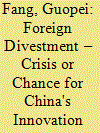

|
|
|
|
|
| Summary/Abstract |
The recent move towards decoupling from China, prompted by the 2018 trade conflict, has implications for the innovativeness of Chinese firms. Using patent data from the Chinese State Intellectual Property Office, together with comprehensive firm-level data, and applying an inverse propensity score reweighting methodology to deal with selection bias, we estimated changes in the patenting activity of firms following ownership transition to Chinese owners, linking these changes to the differential taxation incentives offered to foreign investors. Far from crippling innovation, divestment has sparked an increase in patent applications – including higher end invention patents – and other innovation measures. Together with robustness checks, our estimations suggest a real improvement in innovation rather than just a window-dressing exercise. We suggest that one possible explanation may be an effort by the new Chinese owners to reduce their tax burden. Our supplementary findings on tax payments and subsidy receipts following divestment appear in line with this interpretation.
|
|
|
|
|
|
|
|
|
|
|
|
|
|
|
|
| 15 |
ID:
046214


|
|
|
|
|
| Publication |
Hampshire, Palgrave Macmillan, 2002.
|
| Description |
xiv, 281p.
|
| Standard Number |
0333996277
|
|
|
|
|
|
|
|
|
|
|
|
Copies: C:1/I:0,R:0,Q:0
Circulation
| Accession# | Call# | Current Location | Status | Policy | Location |
| 046119 | 341.759/DRA 046119 | Main | On Shelf | General | |
|
|
|
|
| 16 |
ID:
150070
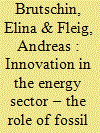

|
|
|
|
|
| Summary/Abstract |
This paper analyzes the effects of fossil fuel rents on R&D expenditures and patent grants in the field of energy-related technology. We argue that an increasing share of fossil fuel rents lessens the innovation of new energy technologies. We consider a sample of countries beyond the common selection of OECD members and investigate innovation efforts in the energy sector of 116 countries from 1980 to 2012. We observe the gradually growing influence of resource-abundant countries on global R&D expenditures and find that increasing fossil fuel rents have a negative effect on patent grants. This study contributes to the ongoing debate concerning the potential effects of resource abundance. More importantly, it increases our understanding of innovation activities within the energy sector and further underscores the need to extend future research to countries that have not been taken into account thus far.
|
|
|
|
|
|
|
|
|
|
|
|
|
|
|
|
| 17 |
ID:
117295


|
|
|
|
|
| Publication |
2013.
|
| Summary/Abstract |
Buildings are crucial to addressing energy problems because they are large consumers of end-use energy, and potential exists to dramatically improve their efficiencies. However, the pace of innovation in buildings is generally characterized as inadequate, despite the implementation of an array of policy instruments aimed at promoting efficiency. The literature on innovation in the building industry provides several explanations including: fragmented decision-making, principal agent problems, inadequate information, and limited learning across heterogeneous projects. We investigate the innovation process for buildings in the U.S. with a case study of patenting in energy management control systems (EMCS) for commercial buildings and programmable thermostats (PT) for residential buildings. Using U.S. patent data, we find that: (1) patenting activity peaked around 1980, subsequently declined, and then increased considerably in the past decade; (2) commercial, rather than residential, buildings account for the recent increase; and (3) building control technologies have benefitted from inventions originating outside the industry, notably from electronics and computers, with a shift toward the latter in recent years.
|
|
|
|
|
|
|
|
|
|
|
|
|
|
|
|
| 18 |
ID:
051214


|
|
|
|
|
| Edition |
3rd ed.
|
| Publication |
Hampshire, Palgrave Macmillan, 2004.
|
| Description |
xxix, 284p.
|
| Standard Number |
1403911797
|
|
|
|
|
|
|
|
|
|
|
|
Copies: C:1/I:0,R:0,Q:0
Circulation
| Accession# | Call# | Current Location | Status | Policy | Location |
| 048167 | 341.758/HAR 048167 | Main | On Shelf | General | |
|
|
|
|
| 19 |
ID:
101069


|
|
|
|
|
| Publication |
2010.
|
| Summary/Abstract |
Do intellectual property rights (IPR) affect foreign direct investment (FDI) into emerging economies? While conventional wisdom supports a strong IPR-FDI relationship, the empirical evidence is both mixed and suffers from several shortcomings. To help resolve this paradox, this article investigates the effects of IPR on US FDI in 22 emerging economies using data from 2006 to 2008. It tests two competing, independent measures of IPR protection, as well as disaggregated FDI data to investigate the effects of IPR protection on investments across nine industries economy-wide, and across eight sectors within the manufacturing industry. The empirical results consistently fail to support the hypothesis that IPR protection strongly affects advanced country FDI into emerging economies. Therefore, developing countries may have considerable leeway in IPR design and enforcement; IPR regimes can be tailored to fit a developing country's domestic socio-economic and cultural conditions without affecting it as a destination for foreign investment. IPRs are not an end-in-themselves, rather they are a means by which to increase investment in innovative activity; they should therefore be designed and enforced with this goal in mind.
|
|
|
|
|
|
|
|
|
|
|
|
|
|
|
|
| 20 |
ID:
143369


|
|
|
|
|
| Summary/Abstract |
This paper analyzes Chinese patenting abroad by constructing a novel database of foreign-oriented patent families (1970–2012) and by distilling stylized facts about China's international patenting strategies. Patent families are a set of related patents filed in one or more foreign jurisdictions to protect the same invention. We find that by the turn of the century China emerged as major actor in terms of international patenting. Nonetheless, the share of Chinese patents which get filed abroad is still a fraction of patents filed at home; most patents abroad also only target one foreign country. Moreover, China's foreign patents are concentrated in a few technology fields and in a few firms, mostly the information technology sector. A shift is underway however to an increased proportion of filings abroad. The paper finds that the main drivers for this change are the desire to facilitate collaboration, to license IP, and to further the firm's reputation as true innovator.
|
|
|
|
|
|
|
|
|
|
|
|
|
|
|
|
|
|
|
|
|